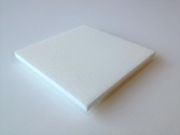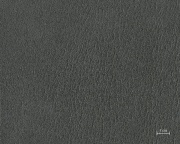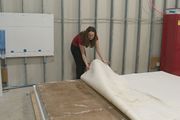Difference between revisions of "Volara"
| Line 5: | Line 5: | ||
== Description == | == Description == | ||
| − | A brand name for a closed cell | + | A brand name for a closed cell, flexible [[polyethylene|polyethylene]] foam. Volara has a smooth surface that is resistant to water absorption and chemical reactions. It is used to line drawers and boxes. Volara is the brand name of a polyolefin-based polyethylene foam from Sekisui Voltec LLC. It is irradiation crosslinked, producing a closed-cell foam with virtually microscopic cells. It has an extremely soft texture throughout, including that of cut surfaces where the tiny cells are presumably broken. Its other desirable qualities include chemical stability, consistent thickness/texture/density, high tensile strength, low water absorption and vapor transmission, workability, and aesthetic appeal, all serving to make it a highly versatile material. |
The surface tension of 2 pcf Volara when pressed with a finger is not unlike that of larger-celled foams with lower densities, such as 0.9 pcf polyethylene. It is very easily cut with a knife - but the blade must be quite sharp to avoid thin bits of "flashing" along the exit edges of the cut. A single slice with the blade will produce a smoother cut than a sawing motion, which can produce a somewhat shredded or faceted appearance. The natural color is a creamy, antique white, or ivory. One or both faces of 1/8" Volara in particular can sometimes have a subtle sheen which will wrinkle softly on the inside of a tight curve, and also display a random network of faint lines, increasing its passing resemblance to human skin. Being crosslinked, Volara is not recyclable. In addition to specialized packaging, Volara is primarily used as carpet padding, gaskets and insulation for vehicles and machinery. | The surface tension of 2 pcf Volara when pressed with a finger is not unlike that of larger-celled foams with lower densities, such as 0.9 pcf polyethylene. It is very easily cut with a knife - but the blade must be quite sharp to avoid thin bits of "flashing" along the exit edges of the cut. A single slice with the blade will produce a smoother cut than a sawing motion, which can produce a somewhat shredded or faceted appearance. The natural color is a creamy, antique white, or ivory. One or both faces of 1/8" Volara in particular can sometimes have a subtle sheen which will wrinkle softly on the inside of a tight curve, and also display a random network of faint lines, increasing its passing resemblance to human skin. Being crosslinked, Volara is not recyclable. In addition to specialized packaging, Volara is primarily used as carpet padding, gaskets and insulation for vehicles and machinery. | ||
Revision as of 19:14, 4 November 2018
Description
A brand name for a closed cell, flexible Polyethylene foam. Volara has a smooth surface that is resistant to water absorption and chemical reactions. It is used to line drawers and boxes. Volara is the brand name of a polyolefin-based polyethylene foam from Sekisui Voltec LLC. It is irradiation crosslinked, producing a closed-cell foam with virtually microscopic cells. It has an extremely soft texture throughout, including that of cut surfaces where the tiny cells are presumably broken. Its other desirable qualities include chemical stability, consistent thickness/texture/density, high tensile strength, low water absorption and vapor transmission, workability, and aesthetic appeal, all serving to make it a highly versatile material.
The surface tension of 2 pcf Volara when pressed with a finger is not unlike that of larger-celled foams with lower densities, such as 0.9 pcf polyethylene. It is very easily cut with a knife - but the blade must be quite sharp to avoid thin bits of "flashing" along the exit edges of the cut. A single slice with the blade will produce a smoother cut than a sawing motion, which can produce a somewhat shredded or faceted appearance. The natural color is a creamy, antique white, or ivory. One or both faces of 1/8" Volara in particular can sometimes have a subtle sheen which will wrinkle softly on the inside of a tight curve, and also display a random network of faint lines, increasing its passing resemblance to human skin. Being crosslinked, Volara is not recyclable. In addition to specialized packaging, Volara is primarily used as carpet padding, gaskets and insulation for vehicles and machinery.
Synonyms and Related Terms
Volara Foam; Volara type A; Voalara-A; XLPE Foam; X-linked PE Foam; Alveolit (EU); Softion (Japan, Australia)
Properties
Volara is perhaps most commonly used as a surface material added to thicker foam cushions. Its silky/rubbery texture, pliability and softness at 2 pcf makes it a useful primary contact material for many unwrapped objects, whether the cushion is a flat surface or a contoured shape. It is also a handy material for shimming inexact foam contours for a better fit. Volara can be used alone when rigid support, such as wood or foam-board bracing, is desired close to the object. Then the main shock-absorption material can surround the exterior of the rigid securing structure. Likewise, Volara can sometimes be used as a vibration-dampening gasket between two hard surfaces, such as a cabinet and its hinged door, or a large object and the structural load spreader beneath it. Finally, Volara is often used as an effective liner for storage shelving and drawers. (Note: It has been known to compress and even stick slightly to the bottoms of glass objects left in place over a long period of time.)
Volara bonds well with itself and with non-crosslinked PE foams, like Ethafoam and PolyPlank, by heat-welding. With practice, large flat surfaces can be heat-welded without overheating the larger-cell PE foam, which can melt under the heat gun and produce dips in the plane. The thinner forms of Volara are pliable enough to heat-weld onto convoluted surfaces, including custom cavities carved into other PE foams. Volara bonds well with hot glue, but it takes care to ensure that beads of glue do not show through the thin material. Volara also bonds very well with 0.003" double-sided PVC film tape. This tape is useful for attaching Volara to hard, flat materials like foam boards or MDO, where beads of hot glue are more likely to partially dry before lamination and show ridges.
On the downside, Volara is easily soiled with dust and dirt, and once smudged it is pretty much impossible to clean. When removing the material from a shop to use on site, it is recommended to wrap it in poly or transport it in a plastic bag. Volara claims excellent thermal insulation, though it is not typically used in art handling with a thickness and coverage comparable to polyurethane or non-crosslinked polyethylene insulates.
Handling and Workability
Volara claims excellent thermal insulation, though it is not typically used in art handling with a thickness and coverage comparable to polyurethane or non-crosslinked polyethylene insulates. Volara is chemically stable, and widely considered an archival material suitable for preventative conservation. It is appropriate for use in long-term storage containers, but care must still be taken to ensure that nothing touches any object surfaces that may become unstable in the storage environment. Volara will not prevent damage to an inherently unstable object in an unregulated environment, should the object's glaze or other surface treatment become re-activated in excessive heat or moisture.
Safety Volara is non-toxic, and it contains no CFC, HCFC, or hydrocarbon blowing agent
Forms and Sizes
In the art handling field Volara is most commonly stocked in one or two forms; 1/4" sheeting in a 60" x 300' roll, and 1/8" sheeting in a 60" x 600' roll. The lightest density available - 2 pcf - is the most useful for securing art objects, whether as a smooth laminate on 2.2 pcf PE foams, or as a buffer between harder surfaces. The natural color is white (ivory).
Other specs are available from the manufacturer however. The density range of the standard formulation is 2 pcf - 20 pcf. Thickness for rolled sheet can be 0.01" - 0.42", and thickness for laminated forms can be 0.5" to 2". Width of rolls can be up to 88". It is also available in 40 colors.
The standard formulation of Volara used in art handling is called Type A. Other formulations created for special purposes include: AF = with fire-retardent properties AS = with deep-draw vacuum forming capabilities EO = with increased flexibility/resiliency/adhesive anchorage G = with further increase in EO qualities LM = with superior heat stability M = with compression-molding capabilities and increased stiffness TS = for industrial tapes and gaskets RSH = for low pressure molding applications. Note that only A, AF, AS, and M are made from polyethylene. The other specialized Volaras are made from alternate polymers.
Applications for Storage Exhibit and transport
Additional Information
Links to Oddy Test results posted on AIC Wiki Materials Database Pages for individual materials below
° Voltek Volara tested in 2016
° black Volara tested in 2016
° black Volara tested in 2013
° Volara tested in 2013
° 10 year old Volara tested in 2013
° achesive backed Volara tested in 2013
° Volara tested in 2008 [[[Slider gallery|aaiPOLEFIN_FOAM.jpg~FTIR]]]
Sources Checked for Data in Record
- Preparation, Art Handling, Collections Care Information Network (PACCIN)
- Pam Hatchfield, Pollutants in the Museum Environment, Archetype Press, London, 2002
- Marie Svoboda, Conservation Survey Index, unpublished, 1997
- Gordon Hanlon, contributed information, 1998
- Conservation Support Systems, Catalog, 1997


